My last few weeks have been spent digging through all the data I could find on the streaming wars. What makes this different than the past is that we finally have a lot of data to parse. Firms like Nielsen, Reelgood, 7 Park and even Netflix themselves have started releasing insights into the streaming wars.
And for the first time, I started to get some insights into Disney’s streaming adventures. Since I was searching for the answer to “How well did Mulan do?”, naturally I found a lot of Disney+ viewership data. And some clear trends emerging about that platform.
Without further ado, 4 insights on Disney’s streaming content strategy. (By the way, these insights are almost exclusively American since we still don’t have great global data.)
Insight 1: Disney is a Hit Driven Business
In entertainment, you don’t win with doubles and singles. You win with grand slams, since grand slams aren’t worth a bit more, but orders of magnitude more. The top film at the box office earns as much as hundreds of other films, for example.
Streaming hasn’t changed that. Hits are as important as ever. In the last quarter, Disney arguably had the most popular streaming release of the year with Hamilton. Check out Google Trends to see how much more interest there was than any other film in over the last three months:

That’s the power of a traditional entertainment studio to find top IP and market it successfully. Going back to launch, arguably Disney+ only succeeded because it launched what is by many metrics the most popular new series in America, The Mandalorian. In other words, in less than a year of existence, Disney launched a show arguably as popular on steaming as Netflix’s top shows (either Stranger Things or The Witcher) and the most popular film of the last quarter. This is a look at just the last week to show how eagerly awaited it still is:
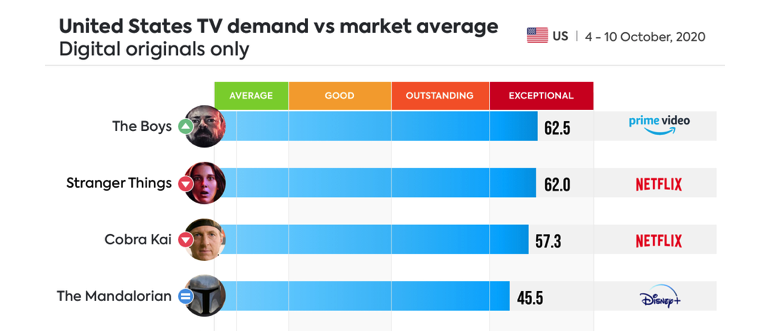
Moreover, as you’d expect, this drives adoption. Here’s Antenna’s sign ups by day chart:
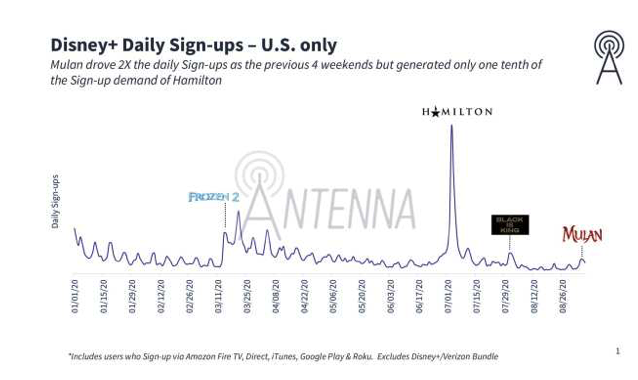
No surprise, but big events drive sign-ups. (And the Covid-19 lock down clearly drove signs up in early March, along with Disney releasing Frozen 2 and Onward early.)
Ramifications
The trouble with a hit driven business is you need to keep producing hits. Something Netflix has learned and worked to address in having a big hit each quarter. Disney will need to do the same, and their approach seems two fold:
– They are building up to a Star Wars or Marvel TV series releasing roughly every quarter.
– Meanwhile, they’ll have their blockbuster films release on roughly a monthly schedule across all their brands likes Disney Animation, Pixar, Star Wars and Marvel.
Of course, the coronavirus-field production shut downs are mauling this plan. Black Widow was delayed into 2021 and the first Marvel TV series—Falcon and Winter Soldier—due in August still hasn’t had a release date announced. As such, until Disney gets the hits rolling, their new subscriber additions will suffer.
Insight 2: Disney+ Is a Kids Platform First and Foremost
In other words, the vast majority of the viewership on the platform comes from kids watching and rewatching Disney films. To emphasize, rewatching popular content. Look at this chart from 7 Park analytics on the most popular content in Q3, through the second weekend of September:

The shiny object is Hamilton. Again it was a beast. But ignore it.
Instead, look at the next film on the list: Frozen 2. Then 5 and 6: Frozen and Moana.
Yep, Frozen 2 is a juggernaut. Kids don’t just watch it, they rewatch it and rewatch it. But notably, this table is of all audience figures, meaning that the largest majority of customers for Disney+ are families streaming kids content.
Ramifications
Disney has successfully grabbed grabbed audience share from Netflix in the kid’s space. Arguably, as one of the most trusted brands in entertainment, they had never completely lost it. But instead of letting Netflix build its brand with kids, Disney now owns that part of the relationship. Indeed, in 7 Park’s data, kids content never shows up for Netflix, but it routinely shows up for Disney+ content.
As for the strategy going forward, even Disney will need to refresh its kids content, releasing new films and TV series to keep kids engaged. You’ll also notice this list is all content released this decade. (I assume this is the Aladdin live-action film.) As strong as Disney’s library is, you need to constantly build new franchises.
Moreover, Disney+ will need those superhero and sci-fi series and films to avoid a reputation as “just” a kids channel. If it is seen as that, that fundamentally limits its global upside.
Insight 3: The Straight-to-Streaming Strategy is Working
You might think I’m talking about Mulan, which would seem to contradict my article from a few weeks back explaining why PVOD didn’t work for Disney. I’m not.
Nor am I talk about straight-to-streaming or quick-to-streaming releases such as Onward (from Pixar), Artemis Foul, or Soul, coming in December. (Also from Pixar.) Those aren’t deliberate choices by Disney, more “best option in a sea of bad options” decisions forced onto them by Covid-19.
Instead, I’m talking about this film in particular…

Again, let’s look at that 7 Park data from above:

The One and Only Ivan held its own against other Disney titles with theatrical releases and in some cases major marketing campaigns. Now, some of this is the impact of marketing the film within the app. Shows and films that get “banner” placement on a streaming app naturally get more clicks. Ivan got lots of that love. And content has been light on Disney+ over the summer, so there were banner spots to be had. Still, looking at the summer as a whole, this film did well.
Ramifications
Well, straight-to-series can work, if you satisfy the number one criteria: keeping budgets in-line with potential SVOD revenue upside.
As well as Ivan did, you can’t attribute lots and lots of customers to it. Instead, this is a solid single that keeps families engaged with Disney+. But it doesn’t drive tons of new acquisition (like Hamilton) or tons of retention (like Frozen/Frozen 2).
What does this mean? Well, it means you need to have budgets that match that level of demand. In other words, straight-to-streaming video needs to have straight-to-streaming budgets. That means that $150 million budgets are out. $50 million production budgets are out. Even budgets about $25 million are dicey.
Disney both understands this and has experience working in this milieu. High School Musical, The Descendants, and Kim Possible are examples of Disney Channel TV movies, some of which were very successful. I’d add the Hallmark Channel and Lifetime have worked in this budget range for decades.
The challenge is understanding budget limitations despite the pressure to compete by spending LOTS more money on content. Activist investor Dan Loeb wants Disney to deficit finance to acquire subscribers. Netflix routinely shells out big, big bucks for straight-to-streaming films. And I’ve said they are losing money on some of these flops twice now. First the Irishman and then their big action films.
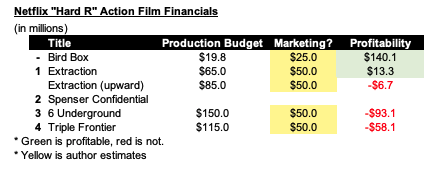
Disney needs to invest in streaming without forgetting that theatrical really drives extra revenue. Or they risk losing as much money as Netflix.
Insight 4: Hulu has not Had the Same Success as Disney+
When I talk streaming and Disney, most folks immediately talk about Disney+. And likely it will be Disney’s largest streamer in America soon. But it’s not Disney’s only streamer! Hulu still exists.
When I reviewed all the potential winners of the last two months, Hulu was notoriously absent. I checked in on season 2 of Pen 15 and Woke, but they barely moved the needle compared to Amazon and Hulu’s champions. Here’s my Google look:
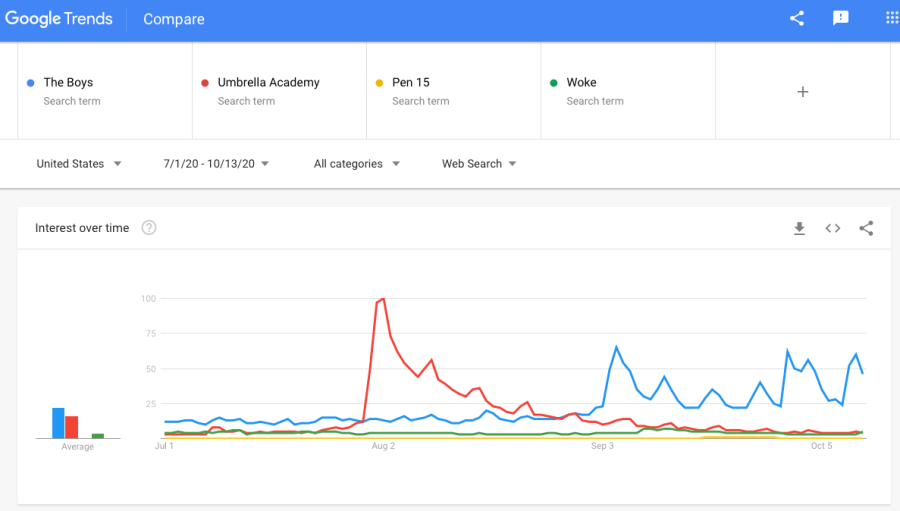
Yep, Hulu’s big releases are the nearly flat yellow and green lines on the bottom. This matches my perception via 7 Park’s data too:
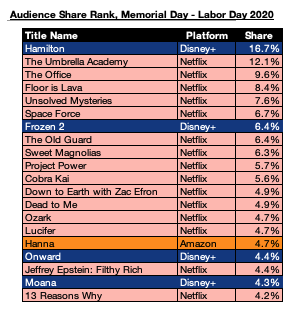
In other words, Hulu didn’t have a great quarter. Hulu’s best content is still library content or second window shows. Which is fine for retaining customers, but not for adding subscribers. Moreover, Hulu runs the same risk that when deals with big traditional studios run out–like Comcast or CBS–they’ll lose those shows.
Ramifications
Frankly, the fewer hits someone has, the likelier their service is to not be used, which means the higher churn will be. That’s the game in the streaming wars. So take a gander at Reelgood’s comparison of Q2 to Q3 performance by it’s users:
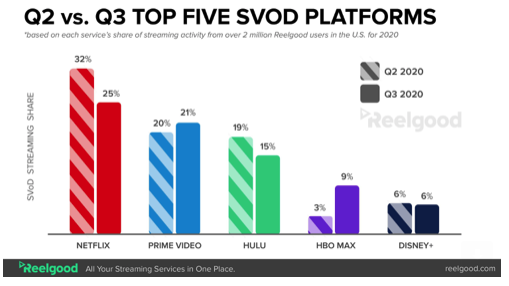
Hulu and Netflix were the services that saw declines; Prime Video and HBO Max saw gains; Disney+ was flat. Hulu is aggressively positioning FX as the brand for that platform. We’ll see if that works, but they need some buzzy shows that drive lots of viewing, and fast. I’d also recommend they focus on crowd pleasing shows—procedurals and sitcoms—which may not win awards or critical plaudits, but that lots of folks watch.

